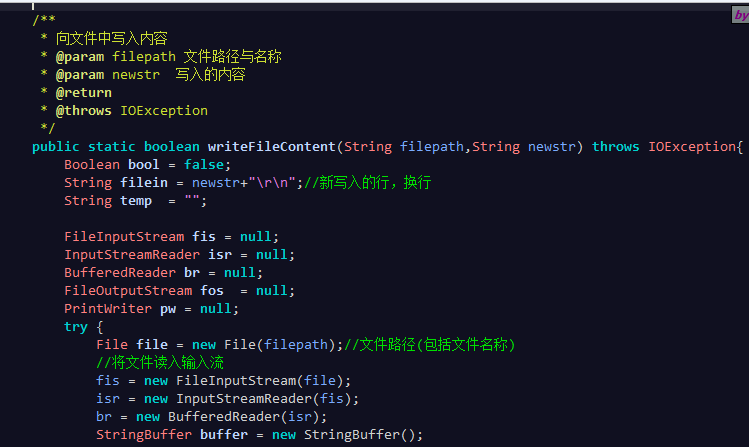前两天在项目中因为要通过http请求获取一个比较大的json数据(300KB左右)并且保存,思来想去,最后还是决定将获取到的json数据以文件的形式保存下来,每次使用的时候去读取文件就可以了。
废话不多说了,直接上代码。
以下是代码截图,文章结尾会有完成的代码文件可供下载。
创建文件方法:

写入文件内容方法:



删除文件方法:

测试:

关于文件创建,写入内容,删除。可以根据自己的情况再稍作修改。
以下是代码类。
|
1
2
3
4
5
6
7
8
9
10
11
12
13
14
15
16
17
18
19
20
21
22
23
24
25
26
27
28
29
30
31
32
33
34
35
36
37
38
39
40
41
42
43
44
45
46
47
48
49
50
51
52
53
54
55
56
57
58
59
60
61
62
63
64
65
66
67
68
69
70
71
72
73
74
75
76
77
78
79
80
81
82
83
84
85
86
87
88
89
90
91
92
93
94
95
96
97
98
99
100
101
102
103
104
105
106
107
108
109
110
111
112
113
114
115
116
117
118
119
120
121
122
123
124
|
package com.file.run;import java.io.BufferedReader;import java.io.File;import java.io.FileInputStream;import java.io.FileOutputStream;import java.io.IOException;import java.io.InputStreamReader;import java.io.PrintWriter;import java.util.UUID;/** * @author 夕橘子-O* @version 2016年7月8日 上午10:38:49 */public class ForFile {//生成文件路径private static String path = "D:\\file\\";//文件路径+名称private static String filenameTemp;/*** 创建文件* @param fileName 文件名称* @param filecontent 文件内容* @return 是否创建成功,成功则返回true*/public static boolean createFile(String fileName,String filecontent){Boolean bool = false;filenameTemp = path+fileName+".txt";//文件路径+名称+文件类型File file = new File(filenameTemp);try {//如果文件不存在,则创建新的文件if(!file.exists()){file.createNewFile();bool = true;System.out.println("success create file,the file is "+filenameTemp);//创建文件成功后,写入内容到文件里writeFileContent(filenameTemp, filecontent);}} catch (Exception e) {e.printStackTrace();}return bool;}/*** 向文件中写入内容* @param filepath 文件路径与名称* @param newstr 写入的内容* @return* @throws IOException*/public static boolean writeFileContent(String filepath,String newstr) throws IOException{Boolean bool = false;String filein = newstr+"\r\n";//新写入的行,换行String temp = "";FileInputStream fis = null;InputStreamReader isr = null;BufferedReader br = null;FileOutputStream fos = null;PrintWriter pw = null;try {File file = new File(filepath);//文件路径(包括文件名称)//将文件读入输入流fis = new FileInputStream(file);isr = new InputStreamReader(fis);br = new BufferedReader(isr);StringBuffer buffer = new StringBuffer();//文件原有内容for(int i=0;(temp =br.readLine())!=null;i++){buffer.append(temp);// 行与行之间的分隔符 相当于“\n”buffer = buffer.append(System.getProperty("line.separator"));}buffer.append(filein);fos = new FileOutputStream(file);pw = new PrintWriter(fos);pw.write(buffer.toString().toCharArray());pw.flush();bool = true;} catch (Exception e) {// TODO: handle exceptione.printStackTrace();}finally {//不要忘记关闭if (pw != null) {pw.close();}if (fos != null) {fos.close();}if (br != null) {br.close();}if (isr != null) {isr.close();}if (fis != null) {fis.close();}}return bool;}/*** 删除文件* @param fileName 文件名称* @return*/public static boolean delFile(String fileName){Boolean bool = false;filenameTemp = path+fileName+".txt";File file = new File(filenameTemp);try {if(file.exists()){file.delete();bool = true;}} catch (Exception e) {// TODO: handle exception}return bool;}public static void main(String[] args) {UUID uuid = UUID.randomUUID();createFile(uuid+"myfile", "我的梦说别停留等待,就让光芒折射泪湿的瞳孔,映出心中最想拥有的彩虹,带我奔向那片有你的天空,因为你是我的梦 我的梦");}} |
以上所述是小编给大家介绍的Java创建文件且写入内容的方法,希望对大家有所帮助,如果大家有任何疑问请给我留言,小编会及时回复大家的。在此也非常感谢大家对服务器之家网站的支持!
原文链接:http://www.cnblogs.com/XiOrang/p/5652875.html














